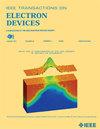低损耗mos可控存储载流子二极管
IF 2.9
2区 工程技术
Q2 ENGINEERING, ELECTRICAL & ELECTRONIC
引用次数: 0
摘要
我们之前提出了一种金属氧化物-半导体可控存储载流子二极管(MOSD),以突破传统p-n二极管的传导损耗和开关损耗之间的权衡。该mossd的结构包括在阳极区域增加一个n沟道金属氧化物半导体场效应晶体管(MOSFET),该晶体管动态控制载流子密度。本研究的仿真结果表明,由于深p−层完全覆盖MOS栅极,与MOSFET中的门控体二极管相比,我们的mossd可以充分降低开关损耗。窄的电池宽度和电子势垒层(EBL)也分别增强了开关损耗和正向电压(${V}_{\text {F}}$)的降低效果。为了验证这一概念,我们制作了一个6.5 kv MOSD原型。该MOSD由具有存储载流子(TASC)时空控制的高导率绝缘栅双极晶体管(IGBT)驱动,与平面栅IGBT驱动的传统p-n二极管相比,其开关损耗降低了- 43%,${V}_{\text {F}}$降低了- 1.0 V。本文章由计算机程序翻译,如有差异,请以英文原文为准。
Low-Loss MOS-Controllable Stored-Carrier Diode
We previously proposed a metal-oxide–semiconductor-controllable stored-carrier diode (MOSD) to break through the tradeoff between conduction loss and switching loss with a conventional p-n diode. The structure of this MOSD consists of an n-channel metal-oxide–semiconductor field-effect transistor (MOSFET) added to the anode region, which dynamically controls the stored-carrier density. The simulation results for this study indicated that the switching loss for our MOSD can be sufficiently reduced compared with that for a gate-controlled body diode in a MOSFET due to the deep p− layer completely covering the MOS gate. The narrow cell width and electron barrier layer (EBL), which are characteristics of our MOSD, also enhance the reducing effect of switching loss and forward voltage ( ${V}_{\text {F}}$ ), respectively. To verify this concept, we fabricated a prototype 6.5-kV MOSD. This MOSD, driven by a high-conductivity insulated gate bipolar transistor (IGBT) with time and space control of stored carriers (TASC), demonstrated a lower switching loss of −43% and lower ${V}_{\text {F}}$ of −1.0 V compared with those for a conventional p-n diode driven by a planar-gate IGBT.
求助全文
通过发布文献求助,成功后即可免费获取论文全文。
去求助
来源期刊

IEEE Transactions on Electron Devices
工程技术-工程:电子与电气
CiteScore
5.80
自引率
16.10%
发文量
937
审稿时长
3.8 months
期刊介绍:
IEEE Transactions on Electron Devices publishes original and significant contributions relating to the theory, modeling, design, performance and reliability of electron and ion integrated circuit devices and interconnects, involving insulators, metals, organic materials, micro-plasmas, semiconductors, quantum-effect structures, vacuum devices, and emerging materials with applications in bioelectronics, biomedical electronics, computation, communications, displays, microelectromechanics, imaging, micro-actuators, nanoelectronics, optoelectronics, photovoltaics, power ICs and micro-sensors. Tutorial and review papers on these subjects are also published and occasional special issues appear to present a collection of papers which treat particular areas in more depth and breadth.
 求助内容:
求助内容: 应助结果提醒方式:
应助结果提醒方式:


